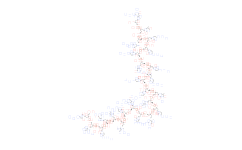Cell membrane blebbing, chromatin condensation, genomic DNA fragmentation, and the exposure of particular phagocytosis signaling molecules on the cell surface are just a few of the distinctive morphological and biochemical features of the cell death process known as apoptosis. Apoptosis-initiated cell death is distinct from necrosis-induced cell death. Apoptotic death, in contrast, is silent and orderly. Necrotic cells are typically recognized as a danger signal by the immune system, which causes inflammation.
There are two main methods for inducing apoptotic cell death: The intrinsic pathway, also known as the Bcl-2-regulated or mitochondrial pathway, is strictly regulated by the BCL-2 family of proteins and is activated by a variety of developmental cues or cytotoxic insults, such as viral infection, DNA damage, and growth-factor deprivation.The tumor necrosis factor (TNF) receptor family members, such as Fas or TNF receptor-1 (TNFR1), which contain an intracellular death domain and can recruit and activate caspase-8 through the adaptor protein Fas-associated death domain (FADD; also known as MORT1) at the cell surface, are what initiate the extrinsic or death-receptor pathway. Without the involvement of the BCL-2 family, this recruitment results in the subsequent activation of downstream (effector) caspases like caspase-3, -6, or -7.
Numerous human diseases, including cancer, viral infections, autoimmune diseases, neurodegenerative disorders, and AIDS (acquired immunodeficiency syndrome), may be influenced by changes in cell survival, according to studies. Some of these diseases may not progress naturally unless specific therapies that change the apoptotic threshold are used.
| Structure | Cat No. | Product Name | CAS No. | Product Description |
|---|---|---|---|---|

|
V52608 | Ritonavir-d6 (ABT 538-d6; RTV-d6) | 1616968-73-0 | Ritonavir-d6 is the deuterium labelled form of Ritonavir. |

|
V38289 | RKI-1447 dihydrochloride | 1782109-09-4 | RKI 1447 di-HCl is a potent and specific ROCK inhibitor (antagonist) with IC50 of 14.5 and 6.2 nM for ROCK1 and ROCK2, respectively. |

|
V6190 | Ro 08-2750 | 37854-59-4 | Ro 08-2750 is a novel, potent, selective,and reversiblenon-peptide inhibitor of Nerve growth factor (NGF), binding to the NGF dimer with a KD of ~ 1 μM. |

|
V54812 | Rocaglaol | 147059-46-9 | Rocaglaol causes apoptosis and cell cycle arrest in LNCaP cells. |

|
V38269 | Rohinitib | 1139253-73-8 | Rohinitib is a potent and specific eIF4A inhibitor. |

|
V38265 | Ropeginterferon alfa-2b (Ropeginterferon alfa-2b-njft; PEG-proline-interferon alpha-2b) | 1335098-50-4 | Ropeginterferon alfa-2b (Ropeginterferon alfa-2b-njft) is a monoPEGylated IFN-α utilized in study/research of myeloproliferative neoplasms. |

|
V53268 | ROS-generating agent 1 | 2369030-41-9 | ROS-generating agent 1 (Compound 2c) covalently modifies the Sec-498 residue of TrxR to generate ROS. |

|
V54881 | Rosamotic acid | 214285-76-4 | Rosamultic acid is an A-ring contractile triterpene that can be extracted from the roots of Rosa rnultiflora. |

|
V54936 | Rosomidnar (PNT100) | 871597-03-4 | PNT100 is an unmodified DNA oligonucleotide sequence that is complementary to the regulatory region upstream of the BCL-2 gene, inhibiting tumor cell proliferation/growth and inducing cell death. |

|
V38152 | RRD-251 | 72214-67-6 | RRD-251 is an inhibitor (blocker/antagonist) of the retinoblastoma tumor suppressor protein (Rb)-Raf-1 interaction (Rb-Raf-1 interaction) and has potent antiproliferation, anti-angiogenic and anti-tumor activities. |

|
V2621 | RRx-001 (ABDNAZ) | 925206-65-1 | RRx-001(RRx001; ABDNAZ) is a novel hypoxia-selectiveepigenetic modulator with potential radiosensitizing and anticancer activity. |

|
V54828 | RUNX-IN-1 | 2177285-35-5 | RUNX-IN-1 Compound Conjugate 1) Covalently binds to the RUNX binding sequence and inhibits/disrupts the binding of RUNX protein to its target site. |

|
V54842 | RUNX-IN-2 | 2893777-88-1 | RUNX-IN-2 (Compound Conjugate 3) covalently binds to the RUNX binding sequence and inhibits/disrupts the binding of the RUNX protein to its target site. |

|
V54995 | Ruplizumab (BG 9588; Anti-Human CD40L Recombinant Antibody) | 220651-94-5 | Ruplizumab (BG 9588) is a humanized monoclonal anti-CD40L (TNF Receptor) IgG1κ antibody. |

|
V34791 | Rutin trihydrate (Rutoside trihydrate; Quercetin 3-O-rutinoside trihydrate) | 250249-75-3 | Rutin (Rutoside) trihydrate is a multifunctional naturally occurring flavonoid glycoside with good antioxidant, anti-inflammatory, anti-diabetic and anti-cancer properties. |

|
V35059 | RWJ-56110 dihydrochloride | 2387505-58-8 | RWJ-56110 di-HCl is a specific, peptidomimetic inhibitor that can suppress PAR-1 activation and internalization (binding IC50=0.44 uM), without affecting PAR-2, PAR-3 and PAR-4. |

|
V35235 | S-Adenosyl-L-methionine (1,4-butanedisulfonate) | 200393-05-1 | S-Adenosyl-L-methionine (S-Adenosyl methionine) 1,4-butanedisulfonate is an orally bioactive methyl donor. |

|
V35236 | S-Allylmercaptocysteine | 2281-22-3 | S-allylmercaptocysteine is an organosulfur compound found in garlic that has anti-inflammatory and antioxidant effects against various lung diseases. |

|
V54854 | S-Gem | 2169925-98-6 | S-Gem is a TrxR-dependent prodrug of Gemcitabine, which is selectively activated by TrxR. |

|
V37701 | S65487 (VOB560) | 1644600-79-2 | S65487 (VOB560) is a potent and specific BCL-2 inhibitor and the precursor of S55746. |